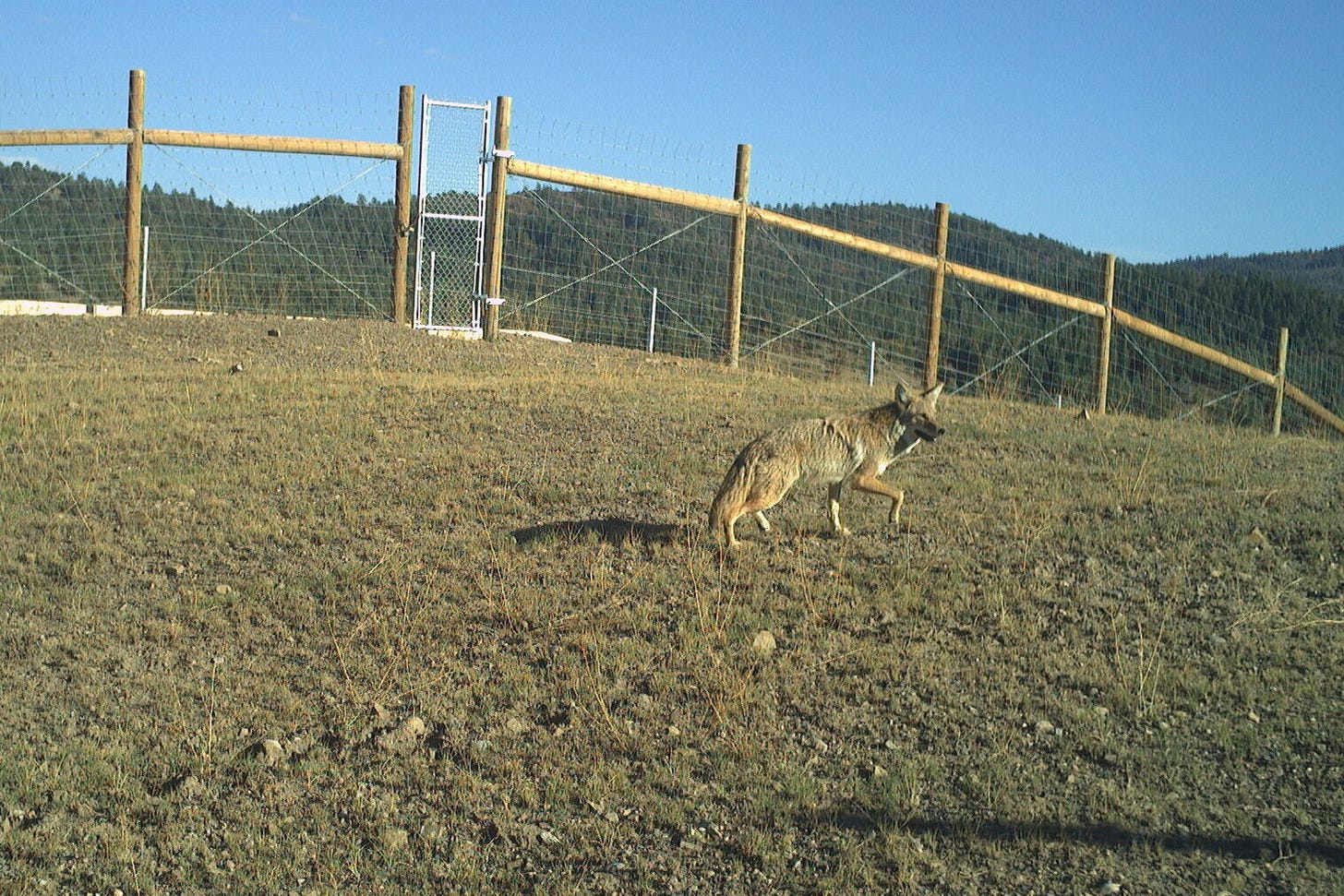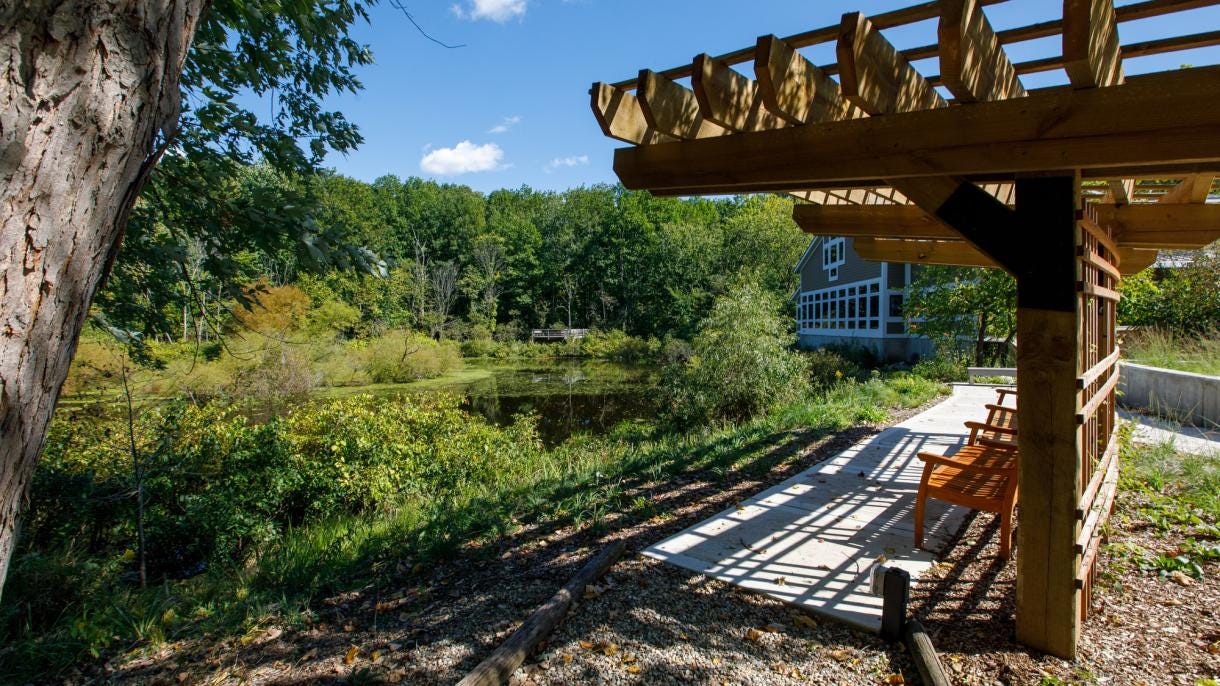Refugia Newsletter #90
Protests, Tesla sales slump, undaunted Colorado, balcony solar, climate risk tool, wildlife crossings, and sandhill cranes.
Refugia News
As you read this today, I am on my way to a Hands Off protest in my town. Are you going to one near you? There’s still time! Today is a nationwide day of action sponsored by, well, every climate and democracy group you can think of. I’m going as a member of Third Act Faith—and just as a horrified citizen. The idea is to get people across the country to show up and protest the cruelty, foolishness, and unconstitutionality of the Trump/Musk/DOGE regime. Rest assured, this is a decidedly nonviolent protest. Find one near you and head out if you can.
You can make a poster by searching for the many images available online and printing one out. Or make your own!
To remind us that protests like this are important, I refer you to this marvelous Substack post by Suzanne Crawford O’Brien. She writes:
It’s easy to think that actions like these are pointless—that they’re “just symbolic.” But oh, Honey, never tell a religious studies professor that something is “just symbolic.” Because symbols have the power to change the world.
O’Brien goes on to explain the importance of ritual—which those of us in faith communities should know all about—and connect rituals to embodied imagining, to new ways of building the world:
Part of the power of ceremony is because ritual spaces—like a good old fashioned protest—are liminal spaces. They are times out of normal time, when the status quo can be temporarily turned on its head. When the power of the carnival, and the camp, and the comedic open up new ways of thinking, new possibilities for being, and new spaces for solidarity.
Protests like this are about building social fabric and making a public show of solidarity. They are not a substitute for the slow grind of working systems and transforming them. Rather, the solidarity-building is essential in fueling that systems-change work.
This is real for me. I do not like crowds. Image credit: Anita Monteiro on Unsplash, via Suzanne Crawford O’Brien
I felt the strength of solidarity in another way last Sunday at a lovely event in Holland, Michigan. Holland is a blue dot in the very red Ottawa county, so it was great to join the Holland UCC folk and other progressive church partners for a panel event called “Our Common Ground: An Earth-Care Conversation.” I got to be on the panel, and we had a strong turnout of enthusiastic people of faith and conscience. Here’s the recording if you’re curious.
Finally, the Refugia Newsletter has now reached 1000 subscribers! Hooray! I know that’s small in the scheme of things, but never mind: it’s a great milestone. Thank you for subscribing and spreading the word. As I’ve said before, I do this work as a service because it’s important. Thanks for being a part of this community.
This Week in Climate News
Well, it was a week of wins and losses for sure. The bizarre and destructive Trump-tariff-trade war is the fresh loss looming over this week, but it’s too soon for me to grapple with the implications for climate work. So hang on while I read further.
For now, let’s talk about the wins. Among them: the Supreme Court race in Wisconsin went to the pro-democracy candidate, Judge Susan Crawford, by about ten points, despite Elon Musk’s illegal attempts to buy the election. A win for democracy is always a win for climate. Meanwhile, Democrats in Florida lost, as expected, in special elections in ruby red districts, but they also way over-performed—and that’s good for democracy, too.
And of course, you saw reports on Sen. Cory Booker’s (D-NJ) marathon senate floor speech stunt this week. As a symbolic action, it was well-designed, well-executed, and well-timed. Did you see clips of Booker quoting scripture? I was very impressed with the exchange between him and Sen. Chris Coons (D-DE). You can view this moment on the video below at about the 5:04:00 mark. Coons quotes Luke 4/Isaiah 61 from memory and the two discuss the passage.
Another win: Tesla sales slump, Tesla stock losses, and global blowback on Elon Musk. This article in the New York Times by Melissa Eddy and Jack Ewing (free link) sums up the situation:
Tesla’s sales have been on a steep downward trend around the world: The company said on Wednesday that its global sales in the first quarter fell 13 percent from a year earlier.
Why? Well, Tesla hasn’t innovated in a while, the Cybertruck was a bust, and competition is surging worldwide in the EV market. But most important of all: Musk has ruined the brand:
The company’s tepid sales at a time when electric vehicle sales were rising around the world reflected a number of serious problems, not least a consumer backlash against the prominent role that Elon Musk, the chief executive of Tesla, is playing in the Trump administration.
Some experts are suggesting that the only way for Tesla to recover is to jettison Musk. Well, good luck. In any case, the rise of many competitors in the EV market is a good thing for clean energy transition. Not sure yet what tariffs will mean for all this.
I may have mentioned before that my husband and I each drive a leased Tesla. My lease is up in August. I will lease another EV, but it won’t be a Tesla. Ron will also move away from Tesla when his lease is up.
It’s such a bummer. I really liked this car. But now I have to resort to this.
Final win today: Colorado remains determined to meet their climate goals even without federal support. Since “sub-national actors” are key to keeping the clean energy transition going during a time of federal hostility, Colorado’s example can be galvanizing for other states. Colorado has ambitious climate goals: reducing greenhouse gas emissions by 50% by 2030—and they are still on track.
An article in Inside Climate News by Wyatt Myskow explains. Gov. Jared Polis has been in office since 2019 and has made climate work a priority. For a while, after the passage of key Biden policies, federal programs supported Colorado’s goals:
Billions of dollars flooded into state and federal agencies in Colorado, as well as to local utilities and businesses, small and large municipalities and even homeowners to expand the state’s renewable energy portfolio, grow its networks of charging stations for electric vehicles, protect communities from drought and wildfire and lower electric bills.
But those days are largely over, with the Trump administration pausing billions in funding for addressing climate change and laying off thousands of workers critical to that work.
Some of the funding freezes have been released, but whether funding will continue is uncertain. Polis is undaunted:
“We are fighting every day in Colorado for cleaner air and to make progress on climate,” Gov. Jared Polis said in an interview with Inside Climate News. “No matter what happens in Washington, no matter what happens in Beijing, no matter what happens in London, we are moving forward here in Colorado with sustainability, affordability and livability, and these are our goals that are intrinsically linked.”
Task list reminder: call your federal reps and insist they fight to keep IRA and Bipartisan Infrastructure Act money flowing to your state. Pressure your state reps to keep working on clean energy transition and land use reform.
Deeper Dive
Three deep dives today: balcony solar follow-up, a rescued extreme weather risk tool, and an explainer for clean tech minerals.
Deep dive #1. In the last newsletter, I covered the recent Utah legislation allowing people to install balcony solar. There was some question about whether any current products met the required standards, though.
Thankfully, my friend Dan Terpstra replied to pass along some new information. He writes that the “problem has been solved” and pointed me to a website for a US company that sells home solar kits including a panels, an inverter, and a battery you just plug in inside your house to store excess energy. Dan writes:
Check out Craftstrom, out of Houston TX. They built a smart power meter and smart inverter that prevents solar power from ever feeding back onto the grid. If it doesn't go onto the grid, it doesn't need an interconnect agreement or licensing or inspections or legislation changes. It’s totally DIY. And behind the meter.
The trick with the NEC approvals in Utah revolves around an obscure situation that might be created if both a consumer of electricity, like a toaster, is plugged into the same circuit as a producer of electricity, like a solar panel. These guys have even solved that problem with what they call a NEC Smart Breaker.
Finally, these guys have smart batteries that charge only when your solar balcony is producing more power than your house is consuming. Instead of pushing it to the grid or throwing it away, the smart circuitry pushes it to the battery as a kind of buffer until the load increases or the sun goes down. Or you could use a dumb battery like an EV that only charges from 10AM to 3PM on a slow charger to make sure there's enough load to soak up the sun.
Thank you, Dan! So we have the technology to make DIY solar energy in our homes without getting anyone else involved, even the utility. Craftstrom has kits for a little over $4000. Plus (as of now) you can still get a tax credit of 30%.
I’m not vouching for this product—I have no idea! I’m just presenting an example of tech that’s coming our way.
Deep dive #2. This one comes under the heading “smart people saving data and information that the Trump regime is trying to purge.” The Guardian newspaper has recreated a climate risk tool formerly sustained by FEMA. Read the article to learn how FEMA employees first attempted to save the tool by changing some terms and keeping quiet. It didn’t work and the FEMA site was purged, but the data has been preserved.
The recreated tool shows risk levels for drought, heat, flooding, hurricanes, and wildfire on a county-by-county basis. You can click on your own county and visualize your relative risk in each category. Thanks to all the people who are taking heroic measures like this.
Guardian graphic. Sources: Fema, popluation from Census Bureau 2020 American Community Survey. Note: Risk ratings are from the mid-century, lower emissions scenario.
Deep dive #3. Grist has created a series explaining everything you might possibly want to know about the minerals necessary to pull off a green energy transition, especially nickel, cobalt, lithium, and copper. Seriously. This is a deep dive to beat deep dives—with some fun graphics, too.
Refugia Sightings
Time for another shout-out to Colorado! Colorado’s wildlife crossings are a great example of refugia corridors. They allow a huge variety of wildlife to cross highways without getting killed by cars—which also endangers drivers, of course.
Catrin Einhorn in the New York Times writes (free link) that Colorado is emerging as a leader in building these crossings:
Since 2015, [Colorado] has built 28 new large game crossing structures, according to the state Transportation Department. …
Wildlife crossings, when combined with long stretches of fencing to funnel animals to the right location, have been found to reduce vehicle collisions with large animals by more than 80 percent.
Who uses these crossings? Moose, bear, mule deer, elk, mountain lions, bobcats, coyotes, foxes, otters—all manner of critters.
In fact, you really must check out this 2021 feature in the New York Times (free link) about wildlife crossings all over the US. It includes terrific video of critters trotting and slinking and padding across this little corridors. Fun!
A coyote trots across a crossing. Image credit: Colorado Department of Transportation via New York Times.
Now let’s make a stop in Nebraska, and read about the annual sandhill crane migration in this article by Sarah Kuta of The Smithsonian.
Wait. Nine million years?! Sandhill cranes have been migrating through Nebraska for nine million years?! Wow. I knew that sandhill cranes were amazing and fascinating and unimaginably ancient. They’re practically dinosaurs. But wow.
Anyway, there was worry this year because some sandhills in the eastern flock were found to have died from H5N1 bird flu in Indiana. However, the western sandhills seem fine:
As they reach the likely peak of their migration this year, the birds seem to be happy and healthy. No crane deaths have been reported in Nebraska so far, reports NTV News’ Jack Bartlett.
Bird flu aside, Nebraska biologists have another reason to celebrate: During their weekly aerial crane survey on March 17, the fifth week of the migration, they counted roughly 736,000 sandhill cranes between the towns of Chapman and Overton, Nebraska, which are roughly 80 miles apart. That’s an all-time, record-high number of cranes counted in the region at once—and it’s probably an underestimate.
I find sandhills gorgeous and weird. We get to see eastern sandhills in northern Michigan in the summer. Image credit: Kylee Warren / Crane Trust via Smithsonian.
This a refugia story, too, because local wildlife managers help the cranes by keeping their favored water stops hospitable:
“What makes the central Platte River valley attractive to sandhill cranes is the river that we help manage,” says Matt Urbanski, a spokesman for the Crane Trust, to KSNB’s Madison Smith. “We will make sure that there’s not a ton of vegetation choking the river out. We’ll make sure that it can widen, so the sandhill cranes have six to eight inches of water to sit in during the nighttime.”
Media Corner
Do you mind if I share with you something that’s important to me? I teach at Calvin University, a small, faith-based, liberal-arts university, and I serve on the “Energy and Environmental Sustainability” committee. In the past two years, we have undertaken to rewrite Calvin’s “Statement on Sustainability.” I was privileged to be the lead writer.
The statement re-establishes the university’s commitment to sustainability (that’s the term we use—it’s neutral), offering a clear, faith-based rationale for the work we do. You can find the statement on this page—click on the little plus signs to get the sections to appear.
Among many other initiatives, Calvin University sustains a beautiful nature preserve, native gardens, and community education center. Image: Calvin.edu.
As you can imagine, we operate in a contested space—people of faith in this country are statistically less likely to understand and care about climate change than people of no faith. However, Calvin University has a long history of sustainability work and we continue to set ambitious goals, including working quickly toward net-zero. We currently have support for our work at every level on campus. The statement was approved this year by the Board of Trustees, Faculty Senate, and Student Senate.
Finally, I’ll share with you a podcast episode that just dropped: “Kipuka to Kipuka: Islands of Life, Faith & Restoration.” Remember that trip to Hawaii last January that I wrote about in newsletter #84? Right, well now you can listen to this beautiful podcast episode and hear for yourself the words of all the amazing people we met on Oahu, doing refugia work, healing land and community. The episode, produced by Jim Stump and Colin Hoogerwerf, is from the Language of God podcast from the good people at BioLogos.
Of course I’m going to end with a Hawaii sunset photo. Obviously.
That’s all for today. Stay resolute. Find your joy. Be well.
As always, bold type in quotations is added unless otherwise indicated.














Congratulations on 1,000 subscribers! Proud to be one of the first 1,000 :)
Thank you Debra, as always, for sharing the good, the bad, and the ugly about the environmental landscape, and especially for refugia good news. In a sense, wildlife crossings act as refugia by enabling wildlife to move across the landscape and thereby avoiding becoming roadkill, as well as reducing fragmentation leading to biodiversity loss and population decline. I really appreciate the article on wildlife crossings in Colorado, I was not aware that they have now built 28 crossings, including some overpasses (very pricey). I think you will be interested in a Gala online teaching tool on 'Wildlife Crossings in Costa Rica' that I worked on with some friends/colleagues a couple of years ago based on a journal article we published: https://www.learngala.com/cases/costa-rica-wildlife-crossings. Yes, wildlife crossings are happening arround the world, and in Costa Rica there is a whole generation of Ticos who are passionate about road ecology and wildlife conservation. On another note, you should be aware of a new film by Ben Albert (grandson of Cal De Witt) called "An Invitation to Wonder" about the Waubesa Wetlands that Cal and his neighbors have worked to preserve for many decades. Cal was director of the Au Sable Institute of Environmental Studies for 25 years, and he appears prominantly in the film. But the real star is the wetlands, and the invitation is to slow down, observe, and behold what God has created. Here is the website link: https://www.learngala.com/cases/costa-rica-wildlife-crossings. We are screening the film at my university (Point Loma Nazarene University) on Earth Day, and I believe there will be quite a few local screenings (Ben is in your neck of the woods). The film can be viewed for free this month, or for $8 via PBS. This film is the perfect refugia film! Cheers, Mike